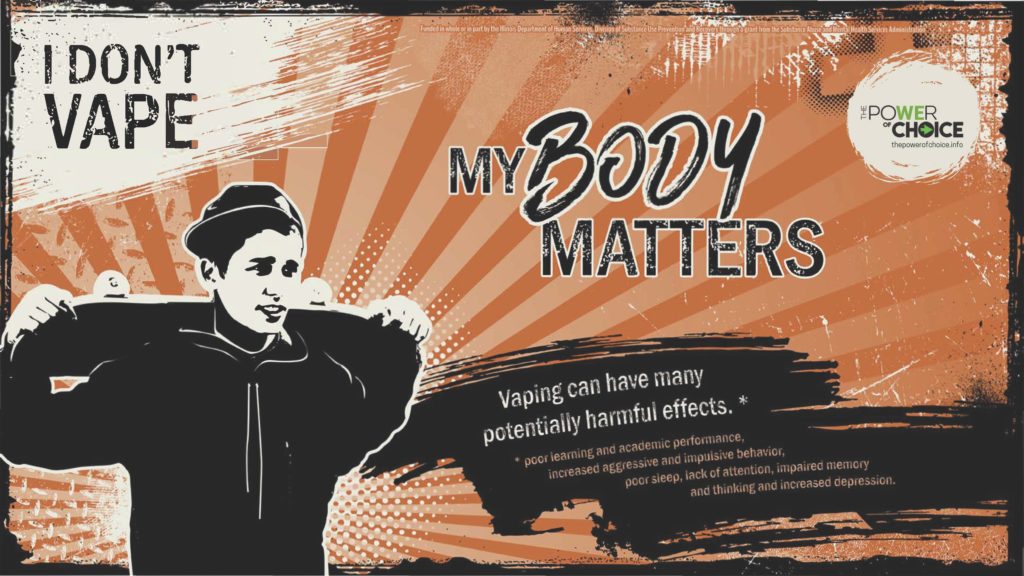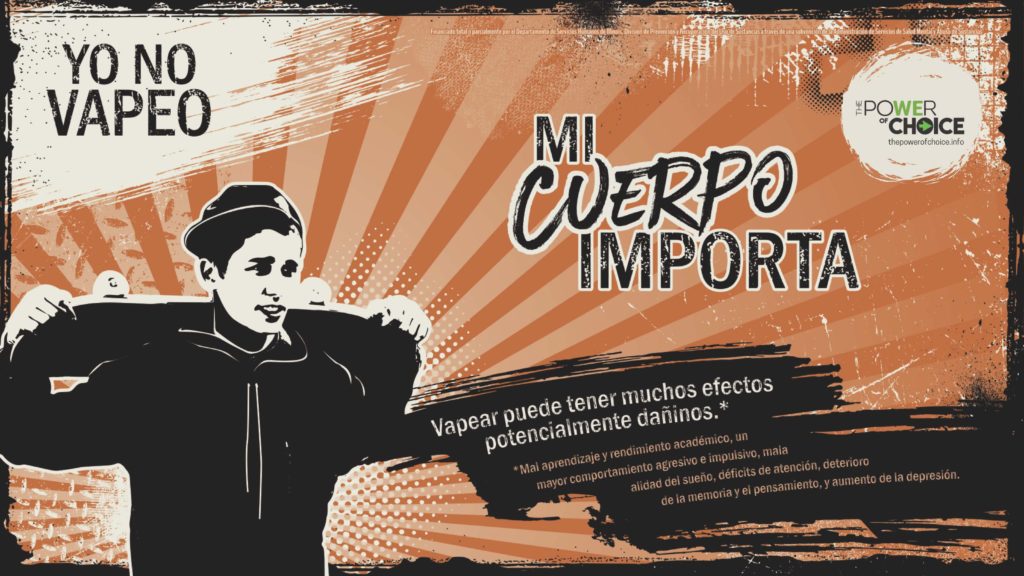Parent Post
The Power of Choice – Middle School Edition
October 2021, Issue 1

Small Conversations Can Have A Big Impact
When it comes to discussing the risks of underage drinking with your teen, there is no magic formula, but there is a major rule of thumb: have frequent small talks. This is one of the keys to keeping your child alcohol-free. It’s not about sitting down for one “big talk.” Not only can this feel intimidating for you and your child, but it is often less impactful. Short conversations over time prove to be more effective.
While it’s essential to begin the conversation when your child is young, the pressures to try alcohol increase as they enter middle school and high school, making the talks even more necessary in the older years.
You may not be able to combat all the pressures your child experiences outside of the home, but you can share the real risks that alcohol can have on their mind, body, and relationships. You can also empower them to stand firm to their convictions and live alcohol-free.
When the Conversations Can Take Place
The chance is that you and your teen are away from each other more often than you are together. From school to recreational activities to maintaining a social life, it may be a struggle to find an overlap in schedules. If this is the case for you and your teenager, take advantage of the moments you are together, whether during the car ride home or right before bedtime.
When having a conversation about the risks of alcohol, remember that it can feel like an awkward or sensitive topic for you and your child. That’s ok. Ensuring that your child’s friends or other people aren’t around can make it more comfortable.
What the Conversations Can Look Like
According to Substance Abuse and Mental Health Association (SAMHSA), when it comes to talking with your teen about not drinking, there are five easy tips to guide the conversation:
1. Show you disapprove of underage drinking.
2. Show you care about your child’s happiness and well-being.
3. Show you’re a good source of information about alcohol.
4. Show you’re paying attention and you’ll notice if your child drinks.
5. Build your child’s skills and strategies for avoiding underage drinking. Remember that you don’t have to get everything across in one sitting. Many small talks work well.
How to Keep the Conversations Positive
Before beginning a conversation around alcohol, gauge your feelings and your teen’s. Make sure everyone’s comfortable and in good spirits before talking. It is best to have a conversation rather than a lecture. This means you are talking with them, not just at them.
(Continued) Listening to your teen, without any interruption, is as important as talking to them. They want to feel heard as much as you do. Give your teenager your full attention during the dialogue. Stay off your phone, make eye contact, and be present. Expect the same from your child. As you prepare to have these frequent conversations about underage drinking with your child, download the ‘Talk. They Hear You.’ mobile app, from SAMSHA. The free app provides tools and information to help you at the touch of your fingertips.

Vaping Prevention at Your Child’s School
We are excited to continue to provide posters and newsletters at your child’s school, educating them on the facts about e-cigarettes/vaping.
You can view the materials on our website here.
Additional Resources
https://www.samhsa.gov/talk-they-hear-you/parent-resources/small-conversations
Connect with Power of Choice
Power of Choice Coordinator
Terra Rumer, CHES
trumer@360youthservices.org
facebook.com/PowerofChoice360
twitter.com/360Prevention
thepowerofchoice.info
Funded in part by the Illinois Department of Human Services, Division of Substance Use Prevention and Recovery through a grant from the Substance Abuse and Mental Health Service Administration.
BOLETÍN PARA PADRES
The Power of Choice – Middle School Edition
Octubre 2021, número 1

Las pequeñas conversaciones pueden tener un gran impacto
Cuando se trata de hablar de los riesgos del consumo de alcohol entre menores con su hijo adolescente, no hay una fórmula mágica, pero sí una regla general: mantener pequeñas conversaciones frecuentes. Esta es una de las claves para mantener a su hijo lejos del alcohol. No se trata de sentarse para tener una “gran charla”. Esto no sólo puede resultar intimidante para usted y su hijo, sino que a menudo tiene menos impacto. Las conversaciones cortas a lo largo del tiempo resultan más eficaces.
Aunque es esencial comenzar la conversación cuando su hijo es joven, las presiones para probar el alcohol aumentan cuando entran en la escuela secundaria e intermedia, lo que hace que las conversaciones sean aún más necesarias cuando son más grandes.
Es posible que no pueda combatir todas las presiones que su hijo experimenta fuera de casa, pero puede explicarle los riesgos reales que el alcohol puede tener en su mente, su cuerpo y sus relaciones. También puede animarlos a mantenerse firmes en sus convicciones y a vivir sin alcohol.
Cuándo pueden tener lugar las conversaciones
Lo más probable es que usted y su hijo adolescente pasen más tiempo separados que juntos. Desde la escuela hasta las actividades recreativas y la vida social, puede ser una lucha encontrar un horario en el que coincidan. Si este es su caso y el de su hijo adolescente, aproveche los momentos en que están juntos, ya sea durante el viaje en coche a casa o justo antes de acostarse.
Cuando tenga una conversación sobre los riesgos del alcohol, recuerde que puede parecer un tema incómodo o delicado para usted y su hijo. Eso está bien. Asegurarse de que los amigos de su hijo u otras personas no están cerca puede hacerlo más cómodo.
Cómo pueden ser las conversaciones
Según la Substance Abuse and Mental Health Association (SAMHSA), cuando se trata de hablar con su hijo adolescente sobre no beber, hay cinco consejos fáciles para guiar la conversación:
1. Demuestre que desaprueba el consumo de alcohol entre menores.
2. Demuestre que se preocupa por la felicidad y el bienestar de su hijo.
3. Demuestre que es una buena fuente de información sobre el alcohol.
4. Demuestre que presta atención y se dará cuenta si su hijo bebe.
5. Desarrolle las habilidades y estrategias para que su hijo evite el consumo de alcohol entre menores. Recuerde que no tiene que transmitir todo en una sola sesión. Muchas charlas pequeñas funcionan bien.
Cómo mantener la conversación positiva
Antes de comenzar con la conversación acerca del alcohol, observe sus sentimientos y los de su hijo adolescente. Asegúrese de que todos están cómodos y de buen humor antes de comenzar a hablar. Es mejor tener una conversación que dar un sermón, esto quiere decir que usted está hablando con ellos, no solo hablándole a ellos.
(Continuación) Escuchar a su hijo, sin ninguna interrupción, es tan importante como hablarle. Ellos quieren sentirse escuchados tanto como usted. Préstele toda su atención durante el diálogo. No use el teléfono, establezca contacto visual y esté presente. Espere lo mismo de su hijo. Mientras se prepara para mantener estas conversaciones frecuentes sobre el consumo de alcohol entre menores con su hijo, descargue la aplicación para celulares ‘Talk. They Hear You.’, de SAMSHA. La aplicación gratuita proporciona herramientas e información para ayudarle al alcance de su mano.

Prevención del vaping en la escuela de su hijo
Estamos muy contentos de seguir proporcionando carteles y boletines en la escuela de su hijo, y educarlos con información sobre los cigarrillos electrónicos/vaporización (vaping).
Puede ver los materiales en nuestro sitio web aquí.
Recursos adicionales
https://www.samhsa.gov/talk-they-hear-you/parent-resources/small-conversations
¡Conéctese con nosotros!
Coordinadora de Power of Choice – Terra Rumer, CHES trumer@360youthservices.org
facebook.com/PowerofChoice360
twitter.com/360Prevention
thepowerofchoice.info
Financiado en parte por el Departamento de Servicios Humanos de Illinois, División de Prevención del Uso de Sustancias y Recuperación a través de una subvención de la Administración de Servicios
de Salud Mental y Abuso de Sustancias


